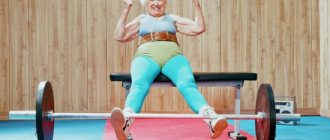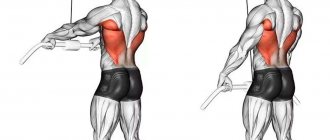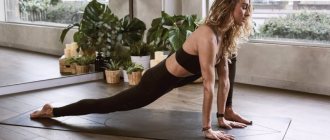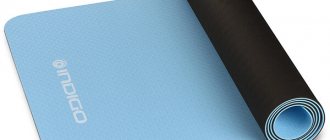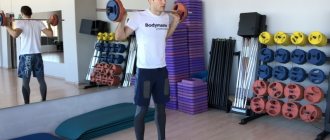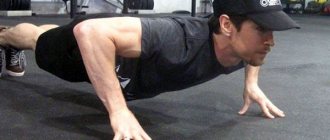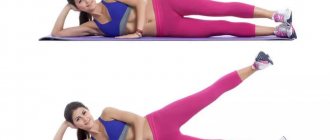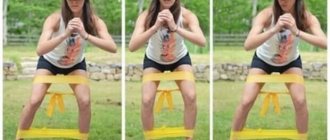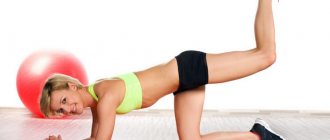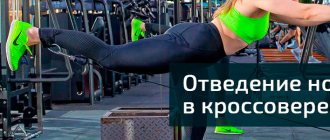Hello friends! This article is for those who are tired of the same type of workouts and want to add unusual exercises to their program. Today I will help you with this.
Let's face it. Over time, training in the gym or on the street begins to become boring. Anyone who has been involved in powerlifting, workout or just street sports for a long time gets tired of monotonous activities. The muscles and the whole body require changes, no matter how ridiculous it may sound.
In this material I will show and talk about 27 of the most unusual exercises for training with your own weight. Unconventional, funny, strange, creative and a large number of other synonyms. You can find the best exercises at home in the article at the link.
PS I won’t hide the fact that I picked up these exercises from fitness bloggers such as Igor Voitenko and Chris Heria.
Slide aerobics
What's the point? Those who know English have already guessed that during training you will need to slide.
Of course, not on ice, but on a special mat measuring 183x61 cm. Before starting classes, you put on special shoe covers made of synthetic fabric - they create a sliding effect. The exercises resemble the movements of a skier, speed skater or roller skater. In the first training sessions, you learn to balance and push off a slide mat with the entire surface of your foot, and then add classic lunges, body twists, and swings of your legs and arms.
Who is it suitable for? Anyone who has decided to get their body in shape, especially overweight people. The workout does not contain jumping, there is no strong stress on the spine and knees. You're just gliding, but you're burning hundreds of calories.
Effect. The volume of the hips is reduced, the buttocks and inner thighs are tightened. Slide aerobics provides aerobic exercise (training the heart muscle), general muscle training and strengthening of joints, develops endurance and improves coordination of movements.
Biceps
Curling your arms with a towel
Main muscle group:
Biceps
Quantity:
5 sets of 10 reps
You don't have to use heavy weights or dumbbells to pump up big cans. Just one towel can fill your biceps to capacity.
Here is what Igor Voitenko advises on performing this exercise:
- Take a towel and roll it into a rope. Grab both ends and place your foot in the middle.
The exercise can be performed in a standing or sitting position , leaning on the wall.
- Curl your biceps, adjusting the difficulty by pressing your foot on the towel.
- When you reach the peak point, begin to extend your biceps while still pressing your foot into the towel.
Reverse Australian Pull-Ups
Main muscle group:
Upper biceps
Quantity:
4 sets of 10 times
Here you will need a low crossbar, approximately at waist level. But again, the lower the bar, the more difficult it is to perform. But how to do it? You ask. Yes, here's how:
- Grab the bar with your palms facing forward.
- Take a couple of steps back to create an inclined body position. At this point you need to bend your back.
- Lower your body all the way down until your arms are completely straight.
- Use your biceps to return your body to the starting position. Then repeat.
Australian pull-ups with reverse grip
Main muscle group:
Short head of biceps
Quantity:
4 sets of 10 reps
Here we also need a low crossbar. If you were able to find a suitable crossbar for the previous exercise, then proceed:
- Grasp the bar with a narrow reverse grip.
- Take a couple of steps forward to create an inclined body position.
- Raise your body so that your forehead touches the bar. Elbows point forward.
- Return to the starting point and repeat the exercise.
Bending your arms on the horizontal bar behind your head
Main muscle group:
Biceps
Quantity:
3 sets of 3-5 times
Overhead pull-ups are a more advanced version of the classic reverse pull-up. In this type of pull-up, the latissimus dorsi muscles work less, and the main emphasis is on the biceps.
Step-by-step guide from Chris Heria:
- To focus on the biceps, you need to take a strong overhand grip. Squeeze the horizontal bar as hard as you can.
- Pull yourself up so that the bar remains behind your head and touches your neck. Elbows should point down.
- Return to starting position and repeat.
One-arm commando pull-up
Main muscle group:
Biceps and forearm
Quantity:
2 sets of 6 reps
Commando pull-ups are one of many types of pull-ups on the horizontal bar. I liked the custom process so I included it on our list.
Here's how to do it:
- Use a commando style grip as shown in the picture.
- Pull yourself up to your right side.
- Remove your left hand and slowly lower yourself down on your right hand. Try to transfer your entire body weight to your right hand.
- Do the same, but for the other side. Now we rise to the left side and remove our right hand.
If this is difficult for you, you can stick with your fingers as you go down.
Bosu
What's the point? Imagine that the familiar fitball was cut into two parts, resulting in a completely different sports equipment. Bosu is a hemispherical platform with a diameter of just over 60 cm with a rubber dome 30 cm high. The elasticity of the dome can be adjusted using special holes for air injection. The simulator can be used both with the canopy down and with the canopy up - it’s not for nothing that its name Both Side Use stands for “use on both sides.”
Exercises with Bosu are reminiscent of both training with a fitball and step aerobics. In addition, the equipment is suitable for Pilates and other types of fitness. Get ready: it won't be easy to resist Bosu, especially the first time.
Who is it suitable for? Anyone who wants to tighten their figure and stay in shape. In addition, the classes will be useful for people involved in active sports (snowboarding, skiing, surfing), as Bosu trains coordination of movements and the ability to group.
Effect. All muscle groups are involved in the training, so the results will not take long to arrive. The benefits of Basu exercises include correcting posture, increasing body flexibility and strengthening joints.
Reverse close grip pull-ups
Another useful back exercise that focuses on the lower lats, plus it's a basic multi-joint movement for biceps development. The recommendations are the same as in the case of pull-ups with a straight wide grip - do not relax your back.
There is no point in making pull-ups any more difficult for experienced athletes; it is enough to go down for 3-4 seconds in each repetition. 10-15 repetitions in 3 sets of each of the mentioned pull-up variations will perfectly work your back, forearms, biceps and rear deltoids.
AntiGravity Yoga
What's the point? Anti-gravity yoga is becoming more and more popular in Russia. The main feature is that classes take place in a light hammock mounted on the ceiling. It is as if you are floating in the air, no longer affected by gravity.
AntiGravity Yoga relieves stress from the spine and relaxes tense muscles. In classes with a hammock you can perform even the most difficult asanas.
Who is it suitable for? For those who dream of not only keeping their body in good shape and becoming more flexible, but also relieving accumulated fatigue, feeling their body and “flying” above the ground. Suspended yoga is recommended for everyone: even those who are not particularly familiar with Eastern practices can start.
Effect. Anti-gravity yoga classes help relieve stress, improve blood circulation, and develop flexibility and plasticity. Exercise strengthens your muscles, renews your body and gives you a feeling of complete relaxation.
Burpee
The following exercise enjoys great authority among athletic enthusiasts. Burpee is performed as follows. From a standing position, you do a deep squat to touch your hands to the floor. Then, leaning on your hands, take a push-up position. Now do everything in the reverse order: bend your knees again, and then stand up. Since this exercise involves the whole body, the heart will begin to pump faster, which will help improve blood circulation. Our expert Krista Stryker says burpees are one of the best exercises for those looking to improve their endurance.
Aquacycling
What's the point? Do you like to ride a bike? What about swimming in the pool? What if you put your bike in the pool? Get aquacycling.
The fact is that water resistance is much greater than air resistance. When you pedal underwater, the load on your leg muscles increases several times. On the contrary, the load on the joints and spine is reduced, which means this sport has practically no contraindications.
Each exercise bike is adjusted to your height and other parameters to make the exercise as comfortable as possible.
Who is it suitable for? For those who want to pump up their buttocks, calves, and reduce the size of their hips and waist.
Effect. Aquacycling not only tightens your figure, trains the abdominal and leg muscles, but also helps in the fight against cellulite (a kind of hydromassage perfectly smoothes the skin in problem areas).
Balancing table pose
If you've ever taken a yoga class, you're probably familiar with the "balance table" position. This is a standard pose in yogic practice, which athletes resort to at the very beginning of training to warm up the entire body. The abdominal and lower back muscles work especially well. Use the “balance table” position if you have problems with movement coordination. This will help you feel balanced when you want to do more challenging exercises. Tip: Coordinate your movements with deep, intense breathing. This will help relieve stress, fatigue and tension.
A Brazilian travels 36 km by bike every day to take his loved one home.
A student at the Vietnam Police Academy shared how she takes care of her facial skin.
Lost weight: what Sofia Tarasova sacrificed for the sake of “VIA Gra” (new photos)
Electromyostimulation
What's the point? Imagine that your workout lasted only 20 minutes, but your muscles feel like you worked out at the gym three times for an hour and a half. Sounds implausible?
The secret is that before training you put on a thin tight suit, and on top of it an electrode vest, belt and cuffs that distribute electromagnetic impulses to different muscle groups.
This is how your muscles tense and relax at a certain speed (sometimes up to several tens of cycles per second!) and in a certain sequence. You can even lie on the floor and your muscles will continue to work.
Who is it suitable for? For those who want to have an excellent figure with minimal impact on training, and for whom strong physical activity is contraindicated.
Effect. Electromyostimulation increases muscle tone: they acquire pronounced relief. Exercise helps reduce body fat and eliminate swelling; in addition, exercise improves blood circulation and stimulates metabolism.
Why shouldn't you complicate the exercises?
squats with a barbell on an unstable support to be the quintessence of “functional training.”
. I have seen variations when a ball is placed under one leg, and the other remains on the floor. Some people manage to assemble a structure of two rollers, on which they lay a board, take a barbell and try to squat on this shaky structure.
I have one question - why? What function do they strive to develop in themselves? No one has yet been able to cancel the principle “what you train is what you train.” So, in my life I have never had the opportunity to face the need to perform squats, trying to balance on an unstable support and holding a weight at the same time. I believe that the vast majority do too.
The question is: what is the purpose of developing such a “valuable” skill? And with a health risk. Squats themselves are a very difficult exercise, classified as traumatic, and here the risk increases further. In such conditions, it seems easier to damage the spine than to strengthen it. Well, or at least get a bunch of bumps on your head and walk around covered in bruises while the skill develops, and the person performing the exercise gets up from the floor over and over again and climbs back onto his shaky platform.
It can be assumed that such, ahem, fanciful techniques allow you to quickly and efficiently (?) become more dexterous, coordinated or resilient? Not really. More precisely, of course, they allow it, but in exactly one single movement (squatting on the ball). For everything else, there is a set of time-tested and science-tested sets of exercises and training methods, among which there will probably be one that will allow you to effectively achieve the desired condition.
View this post on Instagram
Cycling RealRyder
What's the point? A regular exercise bike is too boring: you pedal for an hour and nothing happens. It’s just a matter of fact that the RealRyder is a new product in the world of fitness - the world’s only dynamic cycling trainer. Thanks to the movable frame, you get the complete illusion of a real bike race: with sharp turns, bends, slopes and uphill climbs.
In forty minutes of training you will turn into a real cycling marathon: you will overcome several tens of kilometers over rough terrain or mountains.
Who is it suitable for? For those who love exciting, fun and dynamic workouts, who want to get their body in shape quickly and in an unusual way.
Effect. During classes on RealRyder, the muscles of the legs, abs, lower back and back are involved. The respiratory system and vestibular apparatus work. The body becomes toned and sculpted.
Triceps
Triceps pelvic lift
Main muscle group:
Lateral head of triceps
Quantity:
5 sets of 6-8 times
- Lie on your back and lift your legs up 90 degrees.
- With your palms on the floor, lift your pelvis.
Turn off the press and inertia. perform the load .
French bar press
Main muscle group:
Long head of triceps
Quantity:
3 sets of 8 times
Hannibal push-ups, or as we usually call them, French presses from the horizontal bar. This exercise is not a basic one, it only involves one joint, but it is nevertheless effective for the triceps.
For this exercise you will need a low bar, approximately at the level of your waist. The lower the crossbar, the more difficult it is. Let's finally figure out how to perform a French press from a horizontal bar:
- Take a grip slightly narrower than shoulder level. Take a few steps back and get into a plank-like position. Keep your body tense.
- Make a downward movement. Elbows go down.
- At the bottom point, do the final action - straighten your shoulders, thereby dropping even lower.
- Climb up, pressing your hands on the horizontal bar.
Zoofitness
What's the point? No, this is not a workout for dogs, fish or hamsters. ZUU is a special program that includes exercises that imitate the movements of animals. The basis of the workout consists of only seven movements: pulling, pushing, twisting, bending, squatting, hitting and jumping.
Within one hour you will feel like a flamingo, monkey, panther, crab or frog. By the way, you can do zoo fitness at home.
Who is it suitable for? For those who like classic fitness, but want something original and fun.
Effect. In half an hour of zoofitness you will lose about 500 calories. Classes train the muscles of the abs, legs, buttocks and back.
It's time to sweat!
At the end of each of your complexes, we suggest you perform an exercise that must be performed only on well-warmed muscles.
As you pump your abdominals, you will immediately notice sweat starting to stream from your forehead. Don't underestimate the exercises you do without special equipment or access to a gym. By using your own body weight, you will achieve the same results as sports enthusiasts visiting a fitness center. Full training can be done anywhere. It's time to sweat, and not make excuses and complain about the lack of space!
Found a violation? Report content
Kangoo Jumps
What's the point? Want to jump like a kangaroo? Then try Kangoo Jumps - classes in special boots with springs. One shoe weighs almost two kilograms: just imagine what your feet will be like! The main advantage of training in jumpers is that the load on the muscles increases, and on the joints, on the contrary, decreases (the main load is transferred to the springs of the boots).
It is believed that training in boots with springs is absolutely harmless and has no contraindications: you just need to learn how to keep your balance and you can start training.
Who is it suitable for? For those who want to lose weight, build up their thighs and abdominal muscles, who are prohibited from putting excessive stress on their joints, and who love active and fun workouts.
Effect. The back and inner thighs, abdominal muscles, back and arms are pumped. Thanks to Kangoo Jumps training, the functioning of the cardiovascular system improves, the lymphatic system is activated, the exercises correct posture and strengthen the spine. In one hour of training you will lose almost 1300 calories!
Examples
And a natural question arises: where can I get interesting exercises, games or cases for training? In educational and methodological manuals, on the websites of professional trainers, and simply in the public domain on the Internet, there are a huge number of exercises collected in ready-made sets or “in bulk.” Many of them have multiple purposes, and with a little adaptation can be used to develop a wide variety of qualities, skills and competencies. We will present those that are best remembered by both participants and trainers, and we will also tell you how to adapt this or that exercise to the topic and goals of a particular training.
"Tower of Babel"
A useful and exciting exercise aimed at developing the ability to work in a group, non-verbal communication skills, creativity, and logic of thinking. It is competitive in nature and is suitable for creating an active work environment after warming up.
Content. Teams of participants build the tallest and most stable tower.
Rules. During the construction process, you cannot talk or use your voice at all. Lead time is limited.
Basic materials. Set of paper (A4); tape, scissors - for each team.
Procedure.
- The training group is united into teams of up to 7 people (preferably based on the principle “with whom you interacted least”).
- The coach gives all teams 100-150 sheets of paper (from which they will build a tower), tape, and scissors.
- Within 20 minutes, the teams plan “construction work” (discuss an action plan, create mock-ups of the paper structure).
- Before the start of “construction,” the workpieces are returned to their original state—the sheets are unrolled.
- The teams spend the next 20 minutes rebuilding their towers in deep silence.
- At the trainer's signal, work stops.
- Finished structures are measured with a tape measure and subjected to the test of time. The team whose structure can stand for 1 minute is declared the winner.
After a standing ovation in honor of the best, the following should be discussed with the teams:
- general impression of the game (were the participants comfortable, did they feel confident;
- satisfaction with the result;
- choice of construction strategy (were it possible to plan the work and distribute responsibilities at the preparatory stage);
- whether it was possible to implement it;
- what levels of planning were present and how they were manifested (in planning trainings in the organization);
- how the roles in the team were distributed;
- which of the participants showed themselves to be a leader;
- what he did to get nominated;
- mistakes made:
- what can be changed in a replay.
You should definitely pay attention to the possibility of transferring the acquired skills to planning the work of your department.
The “Tower of Babel” exercise is one of the central exercises for developing team interaction skills in team building and planning training in an organization. But when there is a shortage of time, its modification is often used: teams do not build a tower, but draw it on whatman paper. In this case, each team member receives a sheet with an individual task and is responsible for their own piece of work. For example, the first participant must ensure that the tower has 10 floors, the second - that it has 6 windows, the third - that a blue flag flutters above it, etc. Worksheets with tasks cannot be shown to each other. Everything takes no more than 5-7 minutes. This is followed by a discussion about whether the task was difficult to complete, what was most difficult, whether the interaction within the team was successful and why.
"Associations"
Familiar from childhood, this harmless and fun game is perfect for warming up during training, helps determine the level of knowledge on a topic (set by the trainer) and reveals interesting (and sometimes unexpected) views on certain issues.
Content. Participants express associations that come to mind for given words.
Basic materials. Pens and paper for participants.
Procedure.
- The trainer offers words in such an order that they evoke various non-standard associations (for example, childhood, drug addiction, addiction).
- All representatives of the training group write down 1-2 words of free associations for them one by one.
- Each participant reads out their notes.
- The reasons for the emergence of such associations are discussed.
Thus, the “Associations” exercise creates the basis for subsequent in-depth study of the material or discussion on the topic of the training. So, after the associations given in the example, it would be quite logical to dispel the myths about drug addiction among teenagers.
Sometimes the exercise follows a different scenario - associations are invented for the training participants. The coach gives one of them a soft toy and offers to give it to the second, coming up with an association for him along the way, and so on in a circle. The theme of the game in this case is often the behavior of representatives of the training team. It happens that some of them receive a fair amount of negativity addressed to them. For the coach, this is a signal about the need to understand the reasons and correct the behavior of some participants.
"Traffic light"
A simple but educational “Traffic Light” exercise takes place in the form of a discussion, helps to form a basic concept of the qualities needed by a salesperson, and therefore has long become an integral component of most sales trainings.
Content. Participants create the image of an ideal sales manager.
Basic materials. Stickers in green, yellow, red.
Procedure.
- The trainer asks the group to voice the qualities required for a salesperson. Writes down each sentence on a separate green piece of paper and pins it on the board.
- By analogy, he collects opinions about negative qualities (writes them down on yellow sticky notes) and about what a sales manager should never do (red cards).
- Invites the group to place stickers:
- green - from the most important to the least important quality;
- yellow and red - from worst to best.
The whole process will take about 20-25 minutes.
"Titanic"
A strong, non-standard, complex, ambiguous, interesting exercise - in a word, a challenge. The participants of the training are the sailors and passengers of the magnificent steamship, “sailing” towards the ominous ice iceberg. A coach who is trying to help cope with all the obstacles and give a chance to “survive” the crew and passengers of the gigantic ship that is “wrecked”.
But, alas, as in the Oscar-winning film of the same name, not everyone will be able to escape. There is confusion on the boat deck. The crew members, despite considerable powers and the presence of weapons, participate in the general stampede. At least a third of the passengers do not have enough space in the boats. The captain and his assistants, who, in fact, should lead the “rescue process” are neither seen nor heard. Under the heart-rending howl of an emergency siren and “floating” slides with footage from the film “Titanic,” passengers jump into the cold waters of the North Atlantic...
The ending of this drama may be happy. After analysis and detailed analysis of the reasons for the failure, the coach may give the team a second try. Once again finding themselves in conditions as close to extreme as possible, the participants will mobilize all their personal qualities and, demonstrating unprecedented self-organization, will solve this most difficult task. But that will be a completely different story.
“Titanic” is not just an excellent exercise in team building and personal growth training, it is a quest that requires the total involvement of the entire group. It is unlikely that his characters will be distracted by their own affairs or go out to answer phone calls from colleagues or partners. After all, this is a real test of the ability of training participants to agree among themselves.
"Compliment"
At the end of the training, it would be nice to thank each other for the interesting time spent, and exchange compliments, good wishes and praise. The exercise is designed for an unlimited number of participants.
Content. Members of the training group offer compliments and good wishes.
Decor. It is recommended to include lyrical music.
Procedure.
- Participants stand in 2 circles - outer and inner, facing each other.
- Everyone standing in the outer circle says kind words to the person standing opposite from the inner circle.
- After a minute or two, the turn to give compliments goes to the inner circle.
- The outer circle moves one person to the right - the task is repeated, but with a new partner. And so on until the first pairs match.
In psychological trainings, an advanced version of the exercise is used - participants give compliments to passers-by on the street, in this way getting rid of the fear of communicating with strangers. At the end, you should definitely discuss whether the participants were able to try out any new way of behavior, whether everything worked out for them, what was easier/more difficult - giving or receiving compliments.
"Present"
An excellent “preface” to the topic of general negotiation technology, especially telephone negotiations.
Content. Everyone loves to receive gifts, especially when they give something needed and desired. And so, one of the training participants wants to give a birthday gift to his friend. Using various techniques for identifying needs, he tries to find out what his interlocutor really wants to get. The exercise is performed in pairs.
Procedure.
- Two volunteers sit in the center of the common circle (with their backs to each other). The remaining participants take observer positions.
- The coach distributes roles - which of the two will be the giver and which will be the recipient.
- The giving player finds out the needs of the “birthday boy” - using leading phrases, open, closed and alternative questions. Ask directly, “What should I give you for your birthday?” it is forbidden.
- At the end the following is discussed:
- with the players: did the giver manage to understand the wishes of his friend;
- what techniques did he use for this;
- with observers:
- whether high-quality work has been done to identify the need;
- could it have been possible to spend less time obtaining the necessary information;
- were there any difficulties in negotiating;
- Was the recipient friendly? If not, what mistakes did the interviewing player make that made him angry?
After such a practical summary, it would be appropriate to talk about the skills of effective negotiations and repeat the exercise, but by all group members (in pairs). In conclusion, it is worth finding out whether the couples managed to avoid the mistakes made in the first dialogue. Thus, the “Gift” exercise helps improve information gathering skills and is most appropriate in negotiation training.
"Snowball"
A good way to meet people in a small group. Helps to “defuse” the situation before the start of the program.
Procedure.
- The coach and group sit in a circle.
- 2. The first participant says his name with an adjective that characterizes his strongest side and begins with the same letter as his name. For example, Olga Charming, Marina Mudraya, Sergei Skromny.
- The next person in the circle repeats the name and epithet of the previous participant, and only then calls himself.
- The third participant repeats 2 names with an adjective, and so on. The last speaker will have to name everyone present.
In a large group, the exercise should be performed not according to the “Snowball” principle, but using the “Stitch back needle” method - so that each subsequent player repeats only what was said by the previous one. In this case, the coach can ask: “Who is this?”, and the whole group names the person. Thus, each name is repeated once in chorus, which contributes to better memorization.
"Broken phone"
Its purpose is to show how information is distorted during transmission and to introduce the group to the topic of effective communication. It is recommended to video record when performing
Contents: Team members (7-10 people) take turns passing information to each other.
Basic materials. Cards with message texts.
Procedure.
- One person remains from each team, the rest go out the door.
- The trainer gives an oral message to the remaining participant.
- After listening to him, he invites one of those who came out into the audience and retells him the information.
- The new participant passes on what he remembers to the next one, and so on.
- The information received by the last participant is compared with the original text.
- The team that distorts the information the least wins.
The texts of messages should include sentences that contradict each other in perception. For example, “Marfusha was an exemplary girl, she worked at a factory.” In the understanding of adults, an exemplary girl may be a primary school student, but here she works at a factory. Inconsistencies confuse participants - they may lose sight of something, replace unusual words with more familiar ones, swap blocks of text, or tell a different story.
Who and what, and most importantly, why he interpreted it in his own way, is discussed based on the results of the video recording. You should also analyze whether the interlocutors heard / did not hear (understand / did not understand) each other; whether the listener tried to stop the speaker, ask again, or clarify. Thus, the “Broken Phone” exercise shows training participants how important it is to actively listen and sometimes ask clarifying questions.
"Oranges"
An interesting and effective challenge exercise for negotiation training. Its plot resembles a real economic detective story.
Legend.
The world is on the verge of disaster. J. Johnston, a pharmaceutical company researcher, is researching forms of defense against chemical weapons attacks. A new remedy is almost invented, you just need to add an elixir made from the peels of 3,000 oranges of a very rare variety called solar. They must be of excellent quality.
Unfortunately, this year turned out to be a lean year. But J. Johnston learned from a reliable source that a certain Ed. Fernandez, a fruit exporter from South America, has 4,000 of these oranges. If Mr. J. Johnston had obtained them, he could create a chemical antigas that would neutralize the nerve gas if it were injected into the bomb before the contents leaked. But his financial means for the purchase are limited.
But information about oranges Ed. Fernandez is also known to J. Johnston’s competitor, microbiologist P.V. Smitte. Tom recently managed to develop a substance that treats a new, serious disease caused by a little-studied virus. To complete his work, Dr. Smitta urgently needs the juice from the pulp of 3,000 oranges of the same variety. Then he will be able to produce a medicine with the right composition, cure those who are already sick, and stop the spread of the disease. But he has financial restrictions on the purchase.
Industrial espionage is highly developed in the field of pharmacology. Mr. J. Johnston and Dr. Smitte know each other's plans. In addition Fernandez announced that he would sell the oranges to the highest bidder. Before meeting with him, the competitors decide to negotiate in Dr. Smith's office on his initiative.
Procedure.
- The group is divided into teams of Mr. J. Johnston and Dr. P.V. Smith.
- For 20 minutes, teams analyze cases and plan a negotiation strategy.
- At the end of time, each team nominates one person to negotiate. The rest take observers’ places and write down points that would be useful to discuss at the end of the negotiations, and also note what interferes with or contributes to the agreement
- Negotiations take place in 3 rounds. The first one is 20 minutes. If the parties do not agree, the coach gives a time-out of 5 minutes to re-discuss the negotiation strategy. The time for the second and third rounds is reduced to 15 and 10 minutes. If necessary, you can replace the envoy.
The discussion is based on the results achieved. Often, even experienced negotiators rarely reach an agreement in the second round, and almost never in the first. Teams start with a confident, beautiful argument - they need oranges more. But the “salt” of the task is to realize that in fact different parts of oranges are needed, and it was worth starting with detailed questions to the other team! This is because partners do not have the skills to find out the interests of the other party. But after such a division of oranges, the training participants will forever remember that in order to reach an agreement, you should carefully find out what your partner needs.
"House"
This exercise teaches well-coordinated teamwork and develops leadership skills of training participants.
Content. Teams build a comfortable, spacious, complete and functional house with:
- foundation;
- walls;
- roof;
- door;
- windows;
- internal space (rooms, furniture, interior);
- a small garden in the yard.
Basic materials. Everything that is in the room (chairs, tables, hangers, etc.). You can also use yourself in the construction - someone depicts a wall, a door, pieces of furniture, flowers, etc.
Procedure. The group is united into 2 teams. In each, it is necessary to distribute responsibilities - who is building what (all participants are involved), and choose a foreman. After agreement, the teams build their “houses”. Everything about everything – 15-20 minutes.
By participating in the “Home” exercise, team members, on the one hand, think about their function in the team, realize that they are all needed in their “home” - this promotes cohesion. On the other hand, they explore their leadership style. After all, some people themselves determined their role in the house, while others were appointed. These points should be analyzed after finishing the exercise.
Back
Pull-ups with a towel
Main muscle group:
Lat
Quantity:
5 sets of 10 times
Pull-ups with a towel are an analogue of classic pull-ups, invented by Igor Voitenko (this is not exact). To do this exercise:
- Fold the towel into a rope and lie on the floor.
- Grab both ends of the towel and extend your arms forward. Lift your chest off the floor
- Pull the towel towards your chest, tensing the interscapular muscles.
- Return to the starting position and start over.
iron Man
Main muscle group:
Interscapular
Quantity:
4 sets of 8-10 reps
An exercise with an interesting name and quite interesting execution. Let's take a closer look at it:
- Lie on your stomach and straighten your body. Fingers point back. Palms outside.
- As you inhale, straighten your chest and bring your shoulder blades together. Turn your palms towards the ground, thereby depicting the “flight of the iron man”.
- Return to starting position and repeat.
Butterfly
Main muscle group:
Latissimus and interscapularis
Quantity:
3 sets of 6-8 times
Another back exercise, which again only requires the floor. Instructions:
- Starting position – lying on the floor, arms straight forward.
- As you inhale, rotate your arms in a semicircle so that your fingers point back.
- Using the same rotation, but in the opposite direction, return to the starting position.
Important! When rotating, be sure to bring your shoulder blades together.
Pull-ups with legs
Main muscle group:
Lat
Quantity:
3 sets of 4-6 reps
I don’t remember where I saw this exercise, but one thing I can say for sure is that it is very effective and unusual. When performing, the entire upper back is worked.
To perform it correctly, follow the recommendations below:
- To get into the correct starting position, cross your legs over the bars and hang down as shown in the picture.
- Rise to the top point all the way and squeeze your shoulder blades together. Try to press your elbows closer to your sides.
- Get down.
Fun and unusual exercises for training all muscle groups at home
Hello friends! This article is for those who are tired of the same type of workouts and want to add unusual exercises to their program. Today I will help you with this.
Let's face it. Over time, training in the gym or on the street begins to become boring. Anyone who has been involved in powerlifting, workout or just street sports for a long time gets tired of monotonous activities. The muscles and the whole body require changes, no matter how ridiculous it may sound.
In this material I will show and talk about 27 of the most unusual exercises for training with your own weight. Unconventional, funny, strange, creative and a large number of other synonyms.
PS I won’t hide the fact that I picked up these exercises from fitness bloggers such as Igor Voitenko and Chris Heria.
Shoulders
Elevated Leg Push-Ups
Main muscle group:
Deltoid
Quantity:
4 sets of 6-8 times
For this exercise, you need to find an appropriate elevation no more than 50 cm high.
- Place your feet on a hill so that a right angle is formed between your legs and your body. Lower the top of your head down.
- Lower your body. Elbows point to the sides. The head and hands should be on the same line at the lowest point.
- Rise, and fall again, and rise again, and...
Frog push-ups
Main muscle group:
Front delts
Quantity:
4 sets of 8-10 reps
This type of push-up is great for pumping up the front deltoid, because the load vector will be almost vertical.
- Take a lying position, then bend your knees and place them as close to your elbows as possible. You should end up with a frog-like pose as shown in the picture.
- Lower yourself down to the floor. Try to use your toes as little as possible—use them only for balance.
- Return to the starting position.
The main task is to transfer the entire body weight forward.
Side plank crunches
Main muscle group:
Middle delta
Links to detailed descriptions of exercises from this video
Detailed descriptions of the exercises with photos will be posted in our exercise guide over time.
- Zercher Squats
- Bent-overs with a dumbbell in an outstretched arm
- Raising the body to horizontal while hanging on a horizontal bar
- Raising the body to the horizontal while hanging on a horizontal bar - exercise options
- Lying dumbbell row
- Pull over + French bench press
- Pull over + close grip bench press
- Parallel grip dumbbell bench press
- Dumbbell press up and to the sides
- Dumbbell swings lying on your side
- Deadlift with dumbbells
- Farmer's Walk
- Walking lunges with dumbbells in hands
- One-handed lever pull
- Gladiator press (press one end of the barbell)
Source
